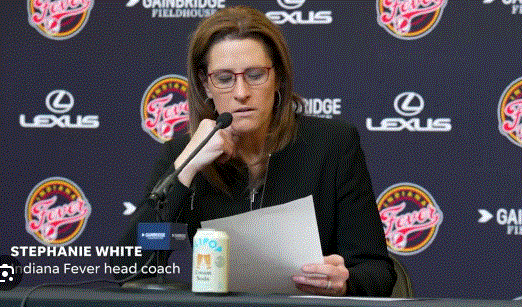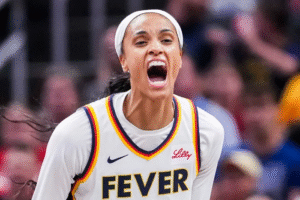
In an ambitious attempt to transform into a WNBA title contender, the Indiana Fever made several high-profile moves during the 2024 offseason. After securing back-to-back No. 1 overall picks in Caitlin Clark and Aliyah Boston, both of whom helped guide the team to a playoff appearance in 2024, the franchise seemed poised to capitalize on the young stars’ rookie contracts by surrounding them with experienced talent. However, recent developments suggest that one of their biggest offseason acquisitions is already falling through, and fans are growing increasingly frustrated with the organization’s direction.

The Fever made sweeping changes in their leadership to start the offseason. They brought in Amber Cox as the new team president, Kelly Krauskopf as general manager, and Stephanie White returned as the head coach. The new leadership quickly moved to bolster the roster by re-signing longtime Fever guard Kelsey Mitchell to a supermax contract valued at $249,244 for the 2025 season. In addition, they signed two accomplished WNBA veterans, DeWanna Bonner and Natasha Howard, each on one-year contracts worth at least $200,000.
These moves were widely interpreted as an aggressive bid to win now. With Clark’s record-breaking popularity and Boston’s interior dominance, the franchise sought to surround its core with proven veterans capable of stabilizing the team and pushing it deep into the postseason. But the plan has not gone smoothly. According to a report released Tuesday by Front Office Sports, Bonner is now seeking to leave the team—just months after joining it.
Bonner, who currently ranks third on the WNBA’s all-time scoring list, has missed the last four games due to what has been officially labeled as “personal reasons.” The report cites limited playing time and an ill-fitting role within the Fever’s system as the main reasons behind her dissatisfaction and desire to part ways. Her performance so far this season has been well below her usual standards, with Bonner averaging just 7.1 points per game—a career low.
Fan reaction to the news has been swift and harsh, especially on social media. Many have directed their frustration at the new front office, blaming them for poor roster decisions and mismanaging the team’s cap space. One user on X (formerly Twitter) remarked, “This front office has done a worse job than Linn Dunn,” referring to the team’s prior leadership. Another commenter expressed dismay over the sizable contract given to Bonner, saying, “Fever wasted 200k smh.”
The criticism isn’t limited to Bonner’s situation. Natasha Howard, another veteran signed in the offseason, has also struggled to make an impact. She’s currently averaging 11.3 points and 6.4 rebounds per game—her lowest statistical output since the 2020 season. Howard’s performance has been underwhelming, particularly considering her significant salary and the expectations surrounding her signing.
The financial commitment to Mitchell, Bonner, and Howard has also placed the Fever in a difficult position regarding roster size. The team began the 2025 season with only 11 active players—one short of the maximum 12 allowed—because of salary cap constraints. This lack of depth has now become more problematic given Bonner’s likely departure and Damiris Dantas’ upcoming absence. Dantas will be representing Brazil at the 2025 FIBA Women’s AmeriCup, which runs from June 28 to July 7, further thinning the team’s frontcourt rotation.
This depleted roster puts even more pressure on Clark and Boston, both still early in their professional careers. While they have shown flashes of brilliance—Clark with her perimeter shooting and playmaking, and Boston with her dominance inside—they need veteran support to ease the burden of carrying the team. Instead, they’re left navigating a situation where the experienced players around them are either underperforming, unavailable, or unhappy.
Supporters of the team have voiced increasing disillusionment with the Fever’s strategy. One fan summed up the general sentiment by declaring, “The Fever offseason was a disaster. We really did not sign one good player. How do you go 0%?” This blunt assessment reflects growing concern that the team squandered a rare window of opportunity.
A large part of the criticism revolves around team chemistry and fit—factors that often determine the success of veteran additions. Bonner, for instance, is a player known for her scoring ability and leadership, but she hasn’t meshed well with the Fever’s system or coaching approach under Stephanie White. Similarly, Howard’s role has looked muddled, and she hasn’t had the expected two-way impact.
Some fans have also second-guessed the Fever’s decision to choose Damiris Dantas over Temi Fagbenle, another frontcourt option. Fagbenle’s physical presence and energy might have been more complementary to the team’s needs, especially in light of Bonner’s situation. Instead, Dantas, while a skilled and versatile forward, will be away during a crucial stretch of the season, adding to the team’s depth woes.
As of now, the Fever hold a 6-7 record and face the Seattle Storm in their next game. While a sub-.500 record isn’t catastrophic at this stage of the season, the overall trajectory appears troubling. The investments in veteran talent have yet to pay off, and internal tensions are now surfacing publicly. If the team doesn’t course-correct soon, its playoff hopes could be in jeopardy, especially given the increasingly competitive landscape of the WNBA.
It’s worth noting that the Fever’s offseason strategy wasn’t necessarily misguided in theory. Building around two young stars on affordable rookie deals is a sound basketball strategy. Many teams have used a similar approach in both the NBA and WNBA—spending aggressively while cornerstones are still under cost-controlled contracts. However, execution is everything, and in Indiana’s case, the specific players chosen, the roles assigned, and the team culture have all fallen short of expectations.
Whether the front office can salvage the situation remains to be seen. A potential trade involving Bonner could bring back needed depth or future assets, but her declining production and salary may limit interest from other teams. Additionally, if the team continues to struggle, questions will inevitably arise about Stephanie White’s fit as head coach and whether further leadership changes are necessary.
For now, the Fever must navigate a rocky road. What was once a promising offseason filled with optimism is now being called a cautionary tale of poor fit, misallocated resources, and missed opportunities. If the franchise hopes to keep building around Clark and Boston long-term, it will need to act quickly and decisively to correct course—and restore some faith among its increasingly skeptical fan base.
Leave a Reply